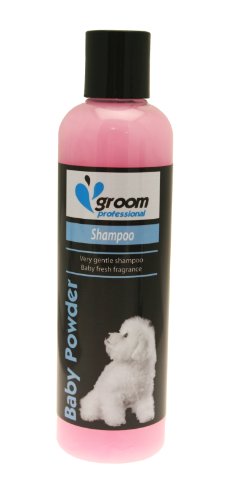
Like dental care amongst humans, regular grooming is the key for a healthy coat for your dog. Failing to groom a dog is equivalent to never washing a child's hair - grooming is essential. Depending on the breed of dog, grooming needs to be more or less regular. For instance, a dog with a long coat needs to have their hair brushed regularly, whilst a short-coated dog may need grooming slightly less regularly. Grooming does not start and end with brushing either. This Dogs.co.uk guide explains the best ways to groom your dog.
Grooming in the home should start with brushing. You should select your brush depending on the type of coat your dog has, and perhaps have more than one brush for specific jobs. A fine-tooth comb can be good for flea control, for instance. Other tools should include clippers for trimming toenails.
When should I start grooming my dog?
Home grooming should start from an early age by teaching the dog to accept the situation. When the dog is a puppy, teach him or her to accept grooming. If you can place a grooming mat on the floor then do so. Pups who have grown up ungroomed may still be taught to stay still enough for grooming, although this may take longer to achieve.
How should I groom my dog?
Grooming a dog that already has a tangled coat can be difficult, so owners should work gently in order to avoid irritating the skin of the dog. Start off by combing the outside of a tangle, and work inwards. If your dog has a particularly matted coat, groom only for short periods of time and make sure to heap praise on your dog if they are well behaved and accept the grooming. If you are being unsuccessful and your dog is responding badly, it may be worth going to a professional for an evaluation.
Why should I groom my dog?
Dogs with long or double coats often shed massive amounts of hair. Some will shed constantly, others annually. Full shedding can take over a month, and your house could become covered in dog hair. All dogs need to be groomed, to keep their coats healthy, but among some dogs grooming is more important.
A dog's coat is rarely silky smooth, and most active dogs have dirt, grit and organic matter in their coats. These can build up and cause mats, which in turn can cause irritation or pain to your dog. Wounds caused by mats can lead to infection, skin disease or fungus.
Which breeds of dog need particular attention to their coats?
Dogs that need particular attention to their coats include the following:
- Afghan Hound
- Cocker Spaniel
- Otterhound
- Bernese Mountain Dog
- Great Pyrenees
- Newfoundland
- Samoyed
- Long-coated St. Bernard
- Maltese
- English Toy Spaniel
- Pomeranian
- Shih Tzu
- Yorkshire Terrier
- Silky Terrier
- Australian Terrier
- Coated Wheaten Terrier
- Bichon Frisé
- Chow Chow
- Keeshond
- Tibetan Spaniel
- Tibetan Terrier
- Finnish Spitz
- American Eskimo
- Bearded Collie
- Belgian Tervuren
- Old English Sheepdog
- Collie
- Briard
- Shetland Sheepdogs
My dog has short hair; does he or she still need grooming?
Unfortunately, all dogs do need their coat groomed. If you have a short-haired breed, it is possible that it won't develop matted or tangled hair, but you should still groom regularly and check your dog's coat. If your dog seems to be shedding, remember that grooming will help the shedding process.
Should I groom my puppy?
Grooming should start early on, and you should teach your puppy to sit down in order to have their coat and body checked, and their hair combed. Grooming can be a great opportunity to bond with and be close to your dog.
What tools should I use to groom my dog?
There are an enormous number of tools on the market to help with dog grooming. These can include combs with a variety of teeth, brushes with a variety of heads, and even gloves to groom short-haired breeds. Grooming accessories include shampoo and conditioners, as well as other supplements to aid the softness and cleanness of coats.
At its most basic level, a home grooming kit for your dog should include a decent brush, a comb with both fine and coarse teeth, and a mat comb for dealing with any tangles. An oil-based conditioner, used both before and after, can be a useful addition.
What should I do if my dog sheds hair?
Just like the hairs on humans, dog hair grows, dies and falls out. Some breeds of dog do not naturally release their dead hair, and it will require special grooming techniques to remove it. Some dogs will shed their hair liberally, particularly those with double-coats. Shedding may take months, but a warm bath can help to speed the process up. Grooming on a daily basis, or in some cases twice daily, will help to control the mass of hair that some dogs can shed.
When owners purchase a long-coated dog, or one that sheds regularly, they should be aware that their pet will require grooming for the duration of his or her life. If the time is not available, professional coat care must be considered.
Choosing a professional dog grooming company
If you do not have the time or physical ability to groom your dog, you can seek a professional dog groomer. This type of professional may also act as a barber, or hair stylist, but many fulfill simply coat care functions. Some veterinary services include grooming and coat care affiliates. You can find dog groomers online or seek a recommendation from your vet. For dogs with more specific coat requirements, it may be necessary to seek professional help from further afield.


























